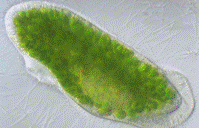Biological Sciences, School of

School of Biological Sciences: Faculty Publications
Document Type
Article
Date of this Version
2005
Citation
Molecular Ecology (2005) 14: 4,453-4,459. DOI: 10.1111/j.1365-294X.2005.02746.x.
Abstract
The spectacular social courtship displays of lekking birds are thought to evolve via sexual selection, but this view does not easily explain the participation of many males that apparently fail to mate. One of several proposed solutions to this ‘lek skew paradox’ is that kin selection favors low-ranking males joining leks to increase the fitness of closely related breeders. We investigated the potential for kin selection to operate in leks of the greater sage grouse, Centrocercus urophasianus, by estimating relatedness between lekking males using microsatellite DNA markers. We also calibrated these estimates using data from known families. Mean relatedness within leks was statistically indistinguishable from zero. We also found no evidence for local clustering of kin during lek display, although males tended to range closer to kin when off the lek. These results make kin selection an unlikely solution to the lek skew paradox in sage grouse. Together with other recent studies, they also raise the question of why kin selection apparently promotes social courtship in some lekking species, but not in others.


Comments
Copyright 2005, Blackwell. Used by permission.